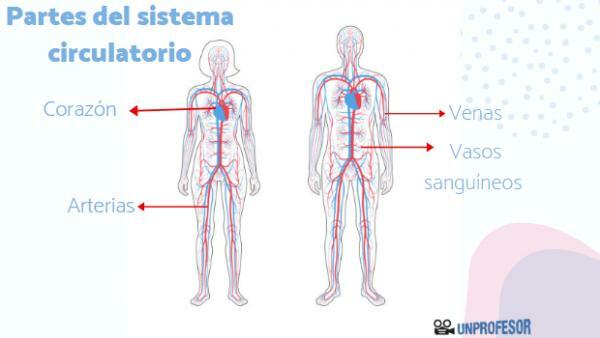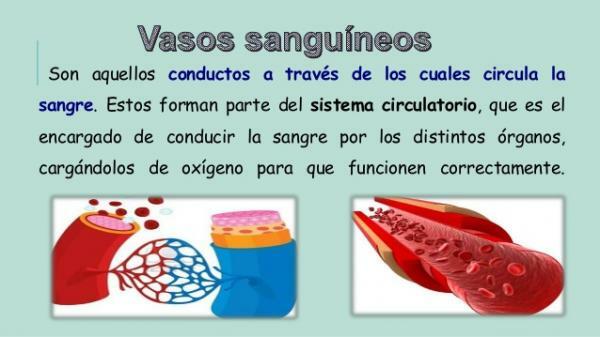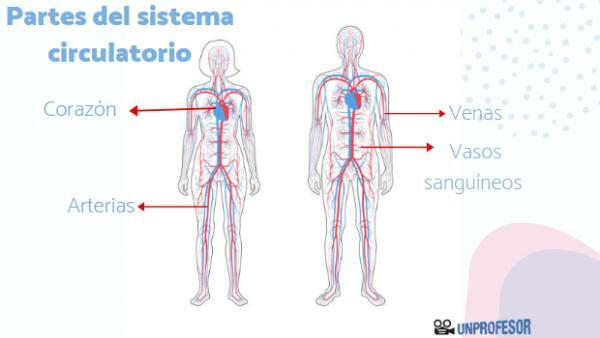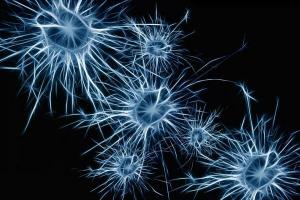Parts of the circulatory system

The human circulatory system is a system in charge of transport nutrients and oxygen to tissues and remove waste and carbon dioxide from inside the body. To do this, it is equipped with a series of parts or components.
In this lesson from a TEACHER we will review the main parts of the circulatory system: blood, blood vessels (arteries, capillaries and veins) and the heart. If you want to know more about each of them and how they all work, we encourage you to keep reading!
Index
- The heart: the pump of the circulatory system
- Blood vessels: arteries, capillaries and veins
- The blood
The heart: the pump of the circulatory system.
Without a doubt, one of the most important parts of the circulatory system is the heart. The heart performs the function of a pump and propels more than 7.5 liters of blood every day, that cover 96,560 kilometers of blood vessels.
The heart is a hollow organ, made up of 4 chambers or cavities that are surrounded by very muscular walls. It weighs between 250 and 300 grams in adults, and is about the size of a closed fist. It is located in the central part of the chest, slightly to the left; in fact, almost two-thirds of the heart is located in the left hemithorax.
The heart wall It is made up of three layers:
- An outer layer, called epicardium.
- An intermediate layer, called myocardium, formed by cardiac muscle tissue.
- An inner layer, called endocardium.
Surrounding these three layers we find the membrane that surrounds the heart and protects it: the pericardium. The pericardium prevents the heart from moving out of position within the chest, while allowing freedom for the heart to stretch and contract.
Parts of the heart
Inside the heart we find 4 cavities: two superior (atria) and two inferior (ventricles). Each of them has characteristics and a function that are very important for the proper functioning of the heart. Generally:
- the right atrium It has thin walls as it receives blood from the body through three vessels: the superior and inferior vena cava and the coronary sinus. Blood flows from the right atrium to the right ventricle through the right atrioventricular orifice, where the tricuspid valve, which receives this name because it has three cusps.
- the Right ventricle It has thick walls since it has to propel the blood, which has almost no pressure, to the lungs. Blood flows from the right ventricle, through the pulmonary lunate valve, towards the trunk of the pulmonary artery. The pulmonary trunk divides into the right pulmonary artery and the left pulmonary artery and carries blood to the lungs to be oxygenated.
- the left atrium It is a thin-walled cavity located behind the right atrium and forms most of the base of the heart. Its large size is due to the fact that it has to receive a large volume of blood from the lungs through the four pulmonary veins. Blood passes from this chamber to the left ventricle through the left atrioventricular orifice, lined by a valve that has two cusps. mitral (or bicuspid) valve.
- the left ventricle It has a thick wall with fleshy trabeculae and tendinous chords. Blood flows from the left ventricle through the semilunar aortic valve toward the aorta artery, with great force.
Therefore, we can say that within the circulatory system there are two circuits of blood circulation, which are connected in the heart: the systemic circulation and the pulmonary circulation. In thesystemic circulation, the blood passes from the left ventricle to the aorta and from there to all the organs and tissues of the body; then the collected blood returns to the right atrium. In the pulmonary circulation, blood is pumped from the right ventricle to the pulmonary artery, which branches in two directions, each of which goes to one of the lungs. The blood is oxygenated in the lungs and leaves them through the pulmonary veins, it goes back to the heart, enters the left atrium and fills the left ventricle to be pumped into the circulation systemic.
Blood vessels: arteries, capillaries and veins.
The blood vessels It is also one of the most important parts of the circulatory system, forming a network of tubes that carry blood from the heart to the tissues and from the tissues to the heart. These blood vessels can have three names, depending on their size and the type of blood they carry.
- The arteries They are blood vessels that distribute blood from the heart to the tissues. Therefore, they are vessels that carry oxygenated blood. The arteries branch and progressively in each branch their caliber decreases and arterioles are formed.
- Within the tissues the arterioles branch into multiple microscopic vessels: the capillaries. Capillaries are very small vessels that are distributed among cells. The walls of the blood capillaries is the place where gas exchange occurs. Therefore, capillaries can carry oxygenated or deoxygenated blood depending on whether they are capillaries entering or leaving the tissue.
- Capillaries unite in groups forming veins. These first veins are small in diameter, which is why they are called venules. These venules fuse to give rise to larger caliber veins: the veins. The veins return the blood to the heart, so they carry deoxygenated blood, rich in carbon dioxide.

Image: Slideshare
The blood.
Blood is the liquid that allows the transport of gases, liquids, cells, proteins, etc. through the human body. It is made up of two parts: a colloidal solution (blood plasma) and a cellular fraction. Approximately 2 liters are made up of cells, while 3 liters are plasma.
The blood functions are diverse and very important and range from the transport of substances to thermal transfer, action buffer, signal transmission (by hormones) to defense against foreign bodies and microorganisms.
Within the cellular fraction of the blood or hematocrit we can find fundamentally three types of cells: erythrocytes, leukocytes, and thrombocytes. The first of them, the erythrocytes, are those that are responsible for the transport of oxygen, thanks to their large amount of hemoglobin. Hemoglobin is capable of retaining or sequestering oxygen, until it reaches the tissues, with great amount of carbon dioxide, where it is able to release and exchange it for carbon dioxide carbon.

If you want to read more articles similar to Parts of the circulatory system, we recommend that you enter our category of biology.
Bibliography
- Dowshen, S (May 2010) The circulatory system and the heart. Recovered from: https://www.rchsd.org/
- Tortosa i Moreno, A (s.f) Cardiovascular system: anatomy. Barcelona Official College of Nurses and Nurses. Recovered from: https://www.infermeravirtual.com/
- Moreno, J.M (s.f) Blood. University of Granada. Recovered from: https://www.ugr.es/~jmmayuso/Archivos%20colgados%20Terapia/La%20sangre%2009-10.pdf


